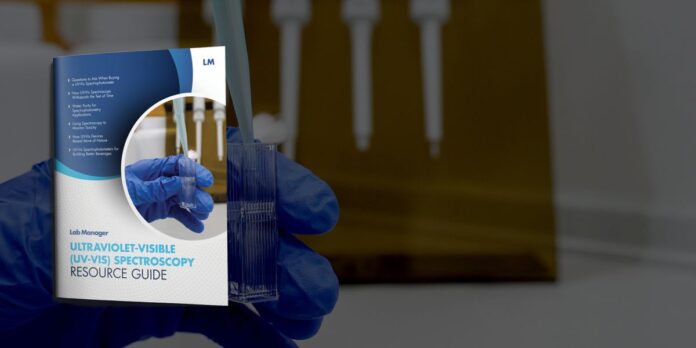Ultraviolet-visible (UV-Vis) spectroscopy is a popular analytical method for determining how much ultraviolet and visible light a material absorbs is called. Used in a wide range of scientific fields, UV-Vis spectroscopy provides a quick and accurate examination of a substance’s optical characteristics, offering priceless information about the molecular structure of the material.
Utilized for qualitative and quantitative analysis, concentration determination, chemical identification, and molecular structure characterization, UV-Vis Spectroscopy has proven essential in modern analytical labs. This article will examine the fundamentals of UV-Vis spectroscopy, as well as its advantages, and uses in various industries.
How Does UV-Vis Spectroscopy Work
The basis of UV-Vis spectroscopy is the measurement of a substance’s absorption of ultraviolet and visible light. A UV-Vis spectrophotometer’s main components include a light source, a data display device, a monochromator, a sample holder, and a detector.
Light Source
A deuterium lamp is usually used for ultraviolet light and a tungsten lamp for visible light in UV-Vis spectrophotometers. The visible and ultraviolet spectrums are both covered by the light emitted by these lamps.
Sample Holder
The sample solution or material for analysis is kept in the sample holder, which is often a glass or quartz cuvette. To provide precise readings, the cuvette needs to be transparent to the light wavelengths being employed.
Monochromator
From the wide range of wavelengths that the light source emits, the monochromator chooses one particular wavelength of light.
This is accomplished by first allowing light to flow through a small opening, and then using a prism or diffraction grating to separate the light into its wavelengths. Only the intended wavelength can reach the sample thanks to the monochromator.
Sample Interaction
The molecules in the sample are affected by the monochromatic light as it travels through the cuvette. The molecules in the sample change from a ground state to an excited state if they have electrons that can absorb energy from the light. Light with those wavelengths is absorbed because the energy needed for this transition is correlated with those wavelengths.
Detector
Following interaction, the detector gauges the amount of light passing through the sample. It does a comparison between the transmitted light’s intensity and the incident light’s intensity before and following the sample. The sample’s absorption of light at the chosen wavelength is indicated by the intensity difference.
Data Display
The absorbance spectrum, or plot of absorbance versus wavelength, is shown by the data display unit. The resulting spectrum gives details on the wavelengths and levels of light absorption at which the sample is absorbed.
Benefits of UV-Vis Spectroscopy
UV-Vis spectroscopy is well known for being quick, easy, and versatile. The method only requires a little preparation of the sample, and the analysis can be finished in a few minutes. Additionally, because it is non-destructive, subsequent tests can be performed on the same material.
All sizes of laboratories can use this technique because UV-Vis spectrophotometers are straightforward to use and reasonably priced. Its sensitivity and selectivity are also quite advantageous, particularly when combined with other analytical methods. This improves its capacity to identify and measure chemicals in complicated mixtures at low concentrations.
Applications of UV-Vis Spectroscopy
The versatility of UV-Vis spectroscopy is demonstrated by the wide range of applications it has in many fields:
Chemical Analysis
It is widely used to analyze both organic and inorganic materials quantitatively and qualitatively. UV-Vis spectroscopy helps pharmaceutical companies maintain quality control by assisting in the measurement of medication concentration in formulations.
Environmental Monitoring
This method is used to find and measure pollutants in the air and water. It can assist with environmental protection efforts by, for instance, measuring the amount of organic contaminants or heavy metals present in water sources.
Food Industry
The analysis of food products, including the identification of pollutants, preservatives, and additives, is aided by UV-Vis spectroscopy. It also contributes to the tracking of food product deterioration.
Studies of Biology
UV-Vis spectroscopy is very useful for researching biological macromolecules like lipids, proteins, and nucleic acids. For example, it can test protein concentration in biochemistry or count nucleic acids in genetic studies.
Material Science
The characterization of optical materials, such as dyes, pigments, and nanomaterials, is aided by UV-Vis spectroscopy. It offers perceptions of the electrical characteristics of materials, which are essential for the advancement of optical technologies and systems.
UV-Vis spectroscopy: A Fundamental Analytical Technique
Although UV-Vis spectroscopy may have certain drawbacks, they are frequently outweighed by its advantages, particularly when combined with other analytical methods to offer a thorough understanding of a substance’s properties.
UV-Vis spectroscopy is vital in propelling scientific advancement and innovation, be it in the creation of novel medications, the surveillance of environmental contaminants, the guarantee of food safety, or the progression of material science.














